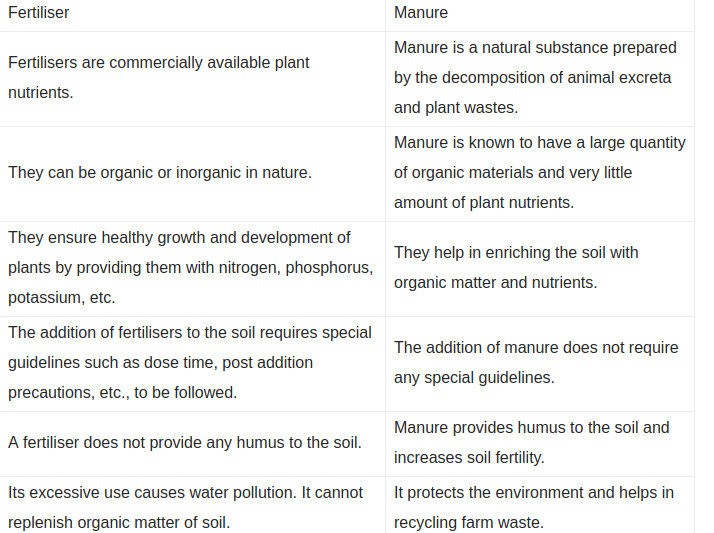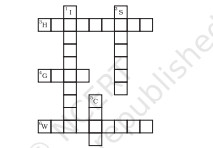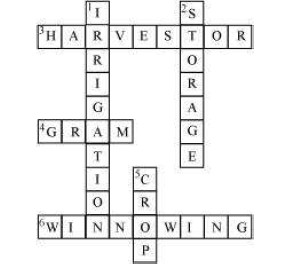Q.1: Select the correct word from the following list and fill in the blanks. float, water, crop, nutrients, preparation
(a) The same kind of plants grown and cultivated on a large scale at a place is called _____________.
(b) The first step before growing crops is _____________ of the soil.
(c) Damaged seeds would _____________ on top of water.
(d) For growing a crop, sufficient sunlight and _____________ and _____________ from the soil are essential.
Ans : (a) The same kind of plants grown and cultivated on a large scale at a place is called crop
(b) The first step before growing crops is preparation
(c) Damaged seeds would float on top of water.
(d) For growing a crop, sufficient sunlight and water and nutrients from the soil are essential.
Q.2: Match items in column A with those in column B.

Ans : 
Q.3: Give two examples of each.
(a) Kharif crop
(b) Rabi crop
Ans : (a) Kharif crop — paddy
(b) Rabi crop — Wheat, gram
Q.4: Write a paragraph in your own words on each of the following.
(a) Preparation of soil
(b) Sowing
(c) Weeding
(d) Threshing
Ans : (a) Preparation of soil:
It is the first method to be followed before growing a crop. This method is usually employed for loosening the soil to allow the root to penetrate deep into it. The loosening of the soil helps in the growth of several soil microbes, earthworms etc., which enrich the soil with humus and other essential nutrients. Plants require nutrients for their proper growth and functioning. The process of loosening is called tilling or ploughing the soil. Tilling of soil brings the nutrient-rich soil to the top. This helps the plants to utilize the nutrients for their growth.
(b) Sowing:
Sowing is another important step in crop production. It is the process of placing the seed in or on the soil for future growth. The seeds that are selected for growing should be of good quality. This will improve the net yield of the crop. Sowing is usually done with the help of either a traditional tool or a seed drill. The traditional tool is shaped like a funnel. It was used earlier for sowing seeds. Nowadays, seed drills that make the use of tractors are used for sowing seeds. This tool disperses seeds uniformly and sows seeds at proper depth. Sowing by this method saves time and also protects the seeds from birds.
(c) Weeding:
Some important weeding methods are:
(i) Weeds can be controlled using weedicides. It is a chemical, which is sprayed in the fields to kill all available weeds. Weedicides are not harmful to crops.
(ii) Tilling before sowing of crops also helps in removing weeds. Tilling uproots the weeds. The best time for removal of weeds is before they produce flowers and seeds.
(iii) The manual method of removing weeds is with the help of a khurpi. It involves regular uprooting or cutting of weeds close to the ground.
(d) Threshing:Threshing is the process of separating grains or seeds from chaff. It is done after harvesting the crop. It is usually carried out with the help of a machine known as 'Combine'. This machine is a combined harvester and thresher. It harvests plants as well as cleans grains.
Q.5: Explain how fertilisers are different from manure.
Ans : Differences between fertilisers and manure:

Q.6: What is irrigation? Describe two methods of irrigation which conserve water
Ans : Irrigation is the process by which water is supplied to crops at different intervals. The time and frequency of irrigation varies according to different seasons, crops, and soil types. There are various sources of irrigation such as wells, canals, rivers, dams, ponds, and lakes. Two methods of irrigation which help in conservation of water are:
a) Sprinkler system: This system is more useful on uneven land, having fewer water supplies. In this method, water is supplied using pipes to one or more central locations within the field. When water is allowed to flow under high pressure with the help of a pump, it gets sprinkled on the crops.
b) Drip system: In this system, water is delivered at or near the roots of plants, drop by drop. This is the most efficient method of irrigation as there is no wastage of water at all. This method is important in areas where water availability is poor.
Q.7: If wheat is sown in the kharif season, what would happen? Discuss
Ans : If wheat is sown in the kharif season (from June to October), then the whole crop might get destroyed because of many factors such as lack of optimum temperature, adaptability, availability of pests, etc. Kharif season includes the rainy season, which is not favourable for the growth of wheat crop. Therefore, wheat crop should not be sown during this season.
Q.8: Explain how soil gets affected by the continuous plantation of crops in a field.
Ans : Continuous plantation of crops in a field makes the soil poor in certain nutrients such as nitrogen, phosphorus, potassium, etc. Plants require nutrients for their proper growth and functioning. When a farmer continues to grow crops one after the other, then all nutrients available in the soil reduce and the crop yield decreases automatically.
Q.9: What are weeds? How can we control them?
Ans : Undesirable plants that grow along with crop plants are known as weeds. Xanthium, Parthenium, etc. are some common weeds. Weeds compete with the crop for nutrients, light, and space. As a result, crop plants get lesser nutrients, light, and space for their development. This in turn, reduces their productivity. Thus, various weeding methods are employed. Some important weeding methods are:
i. Weeds can be controlled using weedicides. It is a chemical, which is sprayed
in the fields to kill all available weeds. Weedicides are not harmful to crops.
ii. Tilling before sowing of crops also helps in removing weeds. Tilling uproots the
weeds. The best time for the removal of weeds is before they produce flowers and
seeds.
iii. The manual method of removing weeds is with the help of a khurpi. It involves regular uprooting or cutting of weeds close to ground
Q.10: Arrange the following boxes in proper order to make a flow chart of sugarcane crop production.

Ans : Flow chart of sugarcane crop production

Q.11: Complete the following word puzzle with the help of clues given below.
Down
1. Providing water to the crops.
2. Keeping crop grains for a long time under proper conditions.
5. Certain plants of the same kind grown on a large scale.
Across
3. A machine used for cutting the matured crop.
4. A rabi crop that is also one of the pulses.
6. A process of separating the grain from chaff.

Ans : Down :
1. IRRIGATION
2. STORAGE
5. CROP
Across :
3. HARVESTER
4. GRAM
6. WINNOWING












No comments:
Post a Comment